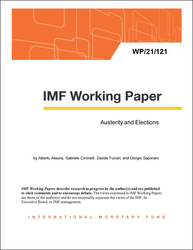
Austerity and Elections
Austerity and Elections
READ MORE...
Volume/Issue:
Volume 2021
Issue 121
Publication date: April 2021
ISBN: 9781513573724
$5.00
Add to Cart by clicking price of the language and format you'd like to purchase
Available Languages and Formats
| English |
Prices in red indicate formats that are not yet available but are forthcoming.
Topics covered in this book
This title contains information about the following subjects.
Click on a subject if you would like to see other titles with the same subjects.
Economics- Macroeconomics , Public Finance , Economics / General , austerity package , expenditure cut , yearly austerity , construction of Austerity variable , economy to Austerity , Tax expenditures , Government debt management
Summary
Conventional wisdom holds that voters punish governments that implement fiscal austerity. Yet, most empirical studies, which rely on ex-post yearly austerity measures, do not find supportive evidence. This paper revisits the issue using action-based, real-time, ex-ante measures of fiscal austerity as well as a new database of changes in vote shares of incumbent parties. The analysis emphasizes the importance of the ‘how’—whether austerity is done via tax hikes or expenditure cuts—and the ‘who’—whether it is carried out by left- vs. right-leaning governments. Our main finding is that tax-based austerity carries large electoral costs, while the effect of expenditure-based consolidations depends on the political-leaning of the government. An austerity package worth 1% of GDP, carried out mostly through tax hikes, reduces the vote share of the leader’s party by about 7%. In contrast, expenditure-based austerity is detrimental for left- but beneficial for right-leaning governments. We also find that the electoral cost of austerity—especially tax hikes—can be contained if it is implemented during good economic times.
Copyright © 2010 - 2025
Powered by:
AIDC



